|
The
come-back of Seymour L. Schnuer on his trip of 1944
From
15th to 23rd June 2006
- Metz
It was during a beautiful week of June 2006 that Seymour
L. Schnuer, veteran of "L" Company 377th
Infantry Regiment, decided to return in the area of Metz
to do again his trip made in 1944.
Indeed, during November 15, 1944 he's wounded whereas his
company moved towards Metz. Thanks to its invaluable
informations and to the military and civil records, we
found the place of his zone of combat as well as the zone
where he was wounded 62 years before!
Here is his story accompanied by photographs taken during
our researchs. (A page is also dedicated to him in “the
Veterans”):
"The
sky was gray, the weather cool, even cold when at dawn we
advanced toward Metz. Our regiment was heading South;
another was heading East, both trying to reach Metz at
about the same time. The Germans were on both sides of the
Moselle River (which became the Mosel when it reached
Germany). The city was perhaps ten miles away.
The advance was slow because German tanks on the other
side of the river were shooting at us. We just kept
shooting our rifles without knowing if we were hitting
anything. Our artillery was trying to knock out the tanks,
but without much result. Sometime in the afternoon the
firing intensified and some of our boys got hit. One in
particular was a lad from Puerto Rico whose mastery of the
English language was minimal. I had taken Spanish for two
years in high school and was sort of friendly towards him.
When he was hit, he started acting crazy. He ran around,
yelling. I went to him and quieted him down. I sprinkled
sulfa powder on his wounded arm, bandaged it up and told
him to wait for the medics. I also tied his handkerchief
to his rifle and stuck it in the ground, bayonet end down.
By the time I finished with him, the rest of my squad had
moved ahead beyond my sight.
By now, I had become an Assistant Squad Leader. Even
though I had achieved that exalted rank, (nearly a
Corporal), I had not let it go to my head. However, I did
feel that I should be with the rest of the squad as soon
as possible. I ran to catch up, but was hampered because
besides my rifle I was carrying a Bangalore Torpedo. This
was a long piece of pipe filled with explosives that was
used to blow a path through various obstacles. On the
other side of the river was a sight to behold. British
Spitfire planes were dive bombing German tanks that were
of course firing back. I kept running and caught up with
some men from another platoon of our company. We were
relatively alone, though. Suddenly the Germans saw us and
started shooting at us. There was a small creek just ten
or twenty yards in front of me and I tried to get there to
be in the shelter of the creek. That was my big mistake. I
just was not fast enough. An 88mm shell landed somewhere
behind me and blew two others and me into the creek.
|
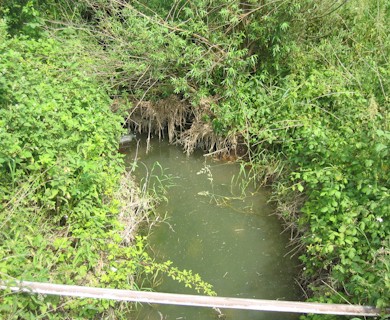
|
| Above :
The
small creek where Seymour Schnuer was projected. |
I
passed out for some unknown time. When I recovered, I
looked at my arm and I could see light through my left
forearm. I applied sulfa and a bandage and looked around.
Two fellow soldiers were in the creek with me, one was
still, and I presumed, dead. The other was groaning. I
asked him how he was and he told me he had been shot in
the leg. It was now late in the afternoon and I said that
we should wait a bit until it got darker and then head
back to try to find a medic.
We waited perhaps an hour and walked back toward a farm
building that we had passed previously. It held one of our
Artillery spotters. As we approached the building, he
limping with me trying to help him, we came upon a tiny
fence, only a flower border really, maybe ten inches high.
My companion could not get over it by himself. I helped
him and we reached the door of the farm building. I opened
the door. The Artillery spotter said something like
“What’s with you two?” I immediately collapsed
and passed out, probably from loss of blood. The next
thing I knew, I was on a stretcher on the back of a jeep
bouncing over a French road. I had been given morphine and
was very groggy. I woke up in a tent hospital in
Verdun."
For information, the soldiers present in this farm during
the night of the 16 - 17 November 1944 were from the HQ of
the Company K of the 377th Infantry Regiment. Any member
of this unit, please contact us to help us in our
researchs.
Thank you.
|
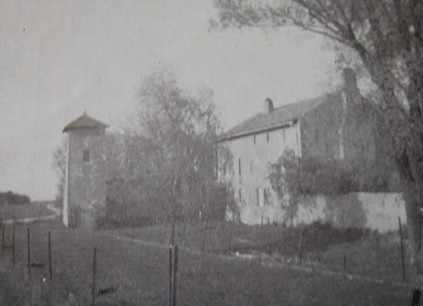
|
|
Above :
The
farm before the WWII.
|
 |
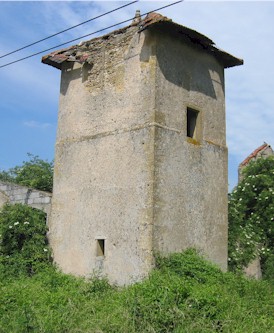 |
| Above :
Rests
of the tiny fence that Seymour L. Schnuer skirted
before to join the farm. |
Above :
Rests
of the tower of the farm. este de la tour de la
ferme. In
the back of this tower, we have found the famous
door. |
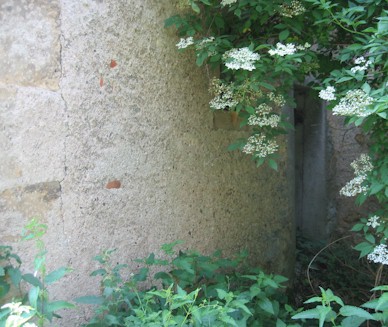 |
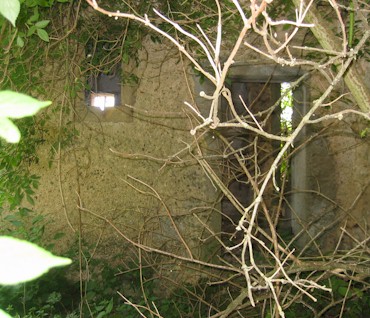 |
| Above :
Rests
of the famous door. |
Above :
Rests
of the famous door, es restes de la fameuse porte,
seen under face. |
After
this discovery, we contacted the local newspapers and
Seymour L. Schnuer was received at the Town hall of Metz.
The
articles of the local newspapers :
|

